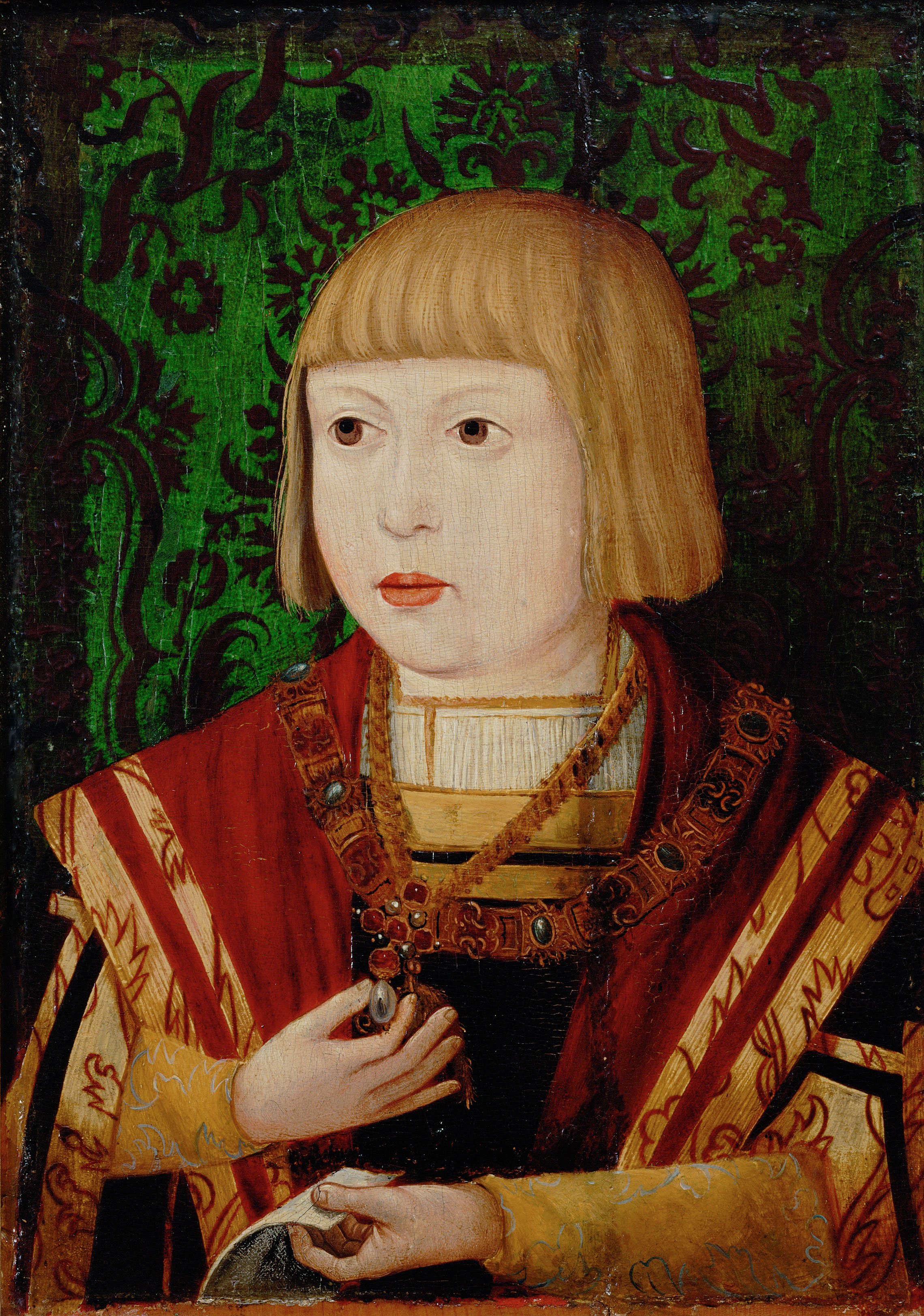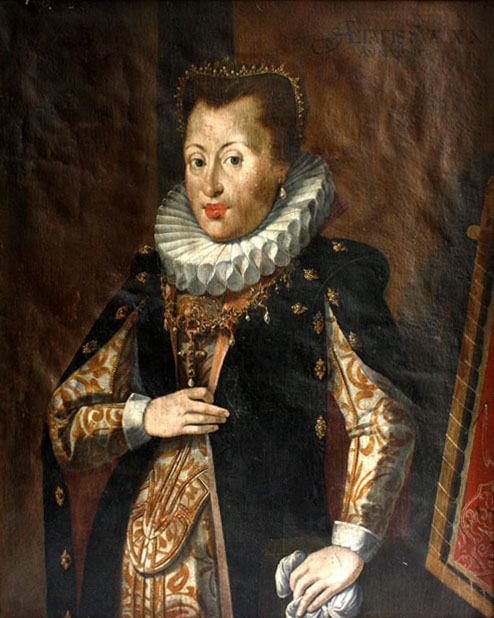|
Archducal Hat Of Tyrol
The archducal hat of Tyrol is an insignia of the County of Tyrol. It is located in the treasury of Mariastein. History Its design resembles the original archducal hat and depictions on coins of the archdukes Ferdinand I and Ferdinand II of Tyrol. It consists of a gilded copper circlet which rests ten triangular gables with precious stones and ornaments. It is closed with two arches surmounted by a globe and cross at the center. The copper circlet is hidden by the crimson cap which was originally turned up with ermine. The ermine has been lost over time and was replaced with silk in ermine pattern. Both the hat and the sceptre were probably made in 1602. Although the Tyrol was a county, the hat is called archducal hat since its ruler Maximilian III was an imperial Habsburg archduke, which is a higher rank than the count of Tyrol. He appears to have considered it unsuitable for his personal use after personal examination of the hat at Innsbruck in 1613.Lord Twining, Edward F ... [...More Info...] [...Related Items...] OR: [Wikipedia] [Google] [Baidu] |
Mariastein - Erzherzogshut , a town in the district of Kufstein in Tyrol, Austria
{{geodis ...
Mariastein may refer to: *Mariastein Abbey at Metzerlen-Mariastein, in the canton of Solothurn, Switzerland *Mariastern Abbey, Banja Luka in Banja Luka, Bosnia and Herzegovina *Mariastein, Tyrol Mariastein is the smallest municipality in the Kufstein district in the Austrian state of Tyrol located 4 kilometers north of Wörgl and 11.5 kilometers southwest of Kufstein. Already a fifteenth century pilgrimage destination,Chizzali. Tyrol: Im ... [...More Info...] [...Related Items...] OR: [Wikipedia] [Google] [Baidu] |
County Of Tyrol
The (Princely) County of Tyrol was an estate of the Holy Roman Empire established about 1140. After 1253, it was ruled by the House of Gorizia and from 1363 by the House of Habsburg. In 1804, the County of Tyrol, unified with the secularised prince-bishoprics of Trent and Brixen, became a crown land of the Austrian Empire. From 1867, it was a Cisleithanian crown land of Austria-Hungary. Today the territory of the historic crown land is divided between the Italian autonomous region of Trentino-Alto Adige/Südtirol and the Austrian state of Tyrol. The two parts are today associated again in the Tyrol–South Tyrol–Trentino Euroregion. History Establishment At least since German king Otto I had conquered the former Lombard kingdom of Italy in 961 and had himself crowned Holy Roman Emperor in Rome, the principal passes of the Eastern Alps had become an important transit area. The German monarchs regularly travelled across Brenner or Reschen Pass on their Ita ... [...More Info...] [...Related Items...] OR: [Wikipedia] [Google] [Baidu] |
Mariastein, Austria
Mariastein is the smallest municipality in the Kufstein district in the Austrian state of Tyrol located 4 kilometers north of Wörgl and 11.5 kilometers southwest of Kufstein. Already a fifteenth century pilgrimage destination,Chizzali. Tyrol: Impressions of Tyrol. (Innsbruck: Alpina Printers and Publishers), p. 43 it became more popular after a local statue of Mary, which had been removed to Bavaria Bavaria ( ; ), officially the Free State of Bavaria (german: Freistaat Bayern, link=no ), is a state in the south-east of Germany. With an area of , Bavaria is the largest German state by land area, comprising roughly a fifth of the total lan ... in the late seventeenth century, was said to have returned to the church in Mariastein on its own. At the center of the community is a 42-metre-tall ''Wohnturm'', a castle built in the fourteenth century atop a rock outcropping, and which contains 250 stairs. It now houses multiple chapels and a museum. References External linksC ... [...More Info...] [...Related Items...] OR: [Wikipedia] [Google] [Baidu] |
Archducal Hat
The archducal hat (german: Erzherzogshut) is the insignia of the Archduchy of Austria, mostly apparently symbolic and used in the heraldry and some portraits of Austrian archdukes rather than routinely worn. One late example is kept in Klosterneuburg Monastery. History The first archducal coronet (''Erzherzogskrone'') was shown on a portrait of Rudolf IV, Duke of Austria, though this coronet probably never existed. Ernest the Iron (1377–1424) had a coronet made, and another was made on the death of Archduke Ferdinand II of the Tyrol in 1595. The final crown of the Archduchy of Austria was made in 1616 for the regent of the Tyrol, Maximilian III. Its place of production remains unknown. It is kept at Klosterneuburg Monastery in Lower Austria. It was brought to Vienna in 1620 for the Ceremony of Homage by the Estates (the so-called '' Erbhuldigung'') for the new ruler, and was last there in 1835. Margaret of Austria, aunt of Emperor Charles V and Regent of the Nethe ... [...More Info...] [...Related Items...] OR: [Wikipedia] [Google] [Baidu] |
Ferdinand I, Holy Roman Emperor
Ferdinand I ( es, Fernando I; 10 March 1503 – 25 July 1564) was Holy Roman Emperor from 1556, King of Bohemia, Hungary, and Croatia from 1526, and Archduke of Austria from 1521 until his death in 1564.Milan Kruhek: Cetin, grad izbornog sabora Kraljevine Hrvatske 1527, Karlovačka Županija, 1997, Karslovac Before his accession as Emperor, he ruled the Austrian hereditary lands of the Habsburgs in the name of his elder brother, Charles V, Holy Roman Emperor. Also, he often served as Charles' representative in the Holy Roman Empire and developed encouraging relationships with German princes. In addition, Ferdinand also developed valuable relationships with the German banking house of Jakob Fugger and the Catalan bank, Banca Palenzuela Levi Kahana. The key events during his reign were the conflict with the Ottoman Empire, which in the 1520s began a great advance into Central Europe, and the Protestant Reformation, which resulted in several wars of religion. Although not ... [...More Info...] [...Related Items...] OR: [Wikipedia] [Google] [Baidu] |
Ferdinand II, Archduke Of Austria
Ferdinand II, Archduke of Further Austria (Linz, 14 June 1529 – 24 January 1595, Innsbruck) was ruler of Further Austria and since 1564 Imperial count of Tirol. The son of Ferdinand I, Holy Roman Emperor, he was married to Philippine Welser in his first marriage. In his second marriage to Anna Juliana Gonzaga, he was the father of Anna of Tyrol, future Holy Roman Empress. Biography Archduke Ferdinand of Austria was the second son of Ferdinand I, Holy Roman Emperor and Anna of Bohemia and Hungary. He was a younger brother of Emperor Maximilian II. At the behest of his father, he was put in charge of the administration of Bohemia in 1547. He also led the campaign against the Turks in Hungary in 1556. In 1557 he was secretly married to Philippine Welser, daughter of a patrician from Augsburg, with whom he had several children. The marriage was only accepted by Emperor Ferdinand I in 1559 under the condition of secrecy. The children were to receive the name "of Aus ... [...More Info...] [...Related Items...] OR: [Wikipedia] [Google] [Baidu] |
Maximilian III, Archduke Of Austria
Maximilian III of Austria, briefly known as Maximilian of Poland during his claim for the throne (12 October 1558 – 2 November 1618), was the Archduke of Further Austria from 1612 until his death. Biography Born in Wiener Neustadt, Maximilian was the fourth son of the emperor Maximilian II and Maria of Spain. He was a grandson of Anna of Bohemia and Hungary, daughter and heiress of Vladislaus II of Bohemia and Hungary, who himself was the eldest son of Casimir IV of Poland from the Jagiellonian Dynasty. From 1585 Maximilian became the Grandmaster of the Teutonic Order; thanks to this he was known by the epithet ''der Deutschmeister'' ("the German Master")In fact, originally the titles ''Hochmeister'' ("Grandmaster") and ''Deutschmeister'' ("German Master") were different: while Grandmaster was the highest order dignitary, the German Master was the third highest and territorially restricted to area of the Holy Roman Empire (apart from Prussia and Livonia) where he administe ... [...More Info...] [...Related Items...] OR: [Wikipedia] [Google] [Baidu] |
Innsbruck
Innsbruck (; bar, Innschbruck, label=Austro-Bavarian ) is the capital of Tyrol and the fifth-largest city in Austria. On the River Inn, at its junction with the Wipp Valley, which provides access to the Brenner Pass to the south, it had a population of 132,493 in 2018. In the broad valley between high mountains, the so-called North Chain in the Karwendel Alps (Hafelekarspitze, ) to the north and Patscherkofel () and Serles () to the south, Innsbruck is an internationally renowned winter sports centre; it hosted the 1964 and 1976 Winter Olympics as well as the 1984 and 1988 Winter Paralympics. It also hosted the first Winter Youth Olympics in 2012. The name means "bridge over the Inn". History Antiquity The earliest traces suggest initial inhabitation in the early Stone Age. Surviving pre-Roman place names show that the area has been populated continuously. In the 4th century the Romans established the army station Veldidena (the name survives in today's urban district Wilt ... [...More Info...] [...Related Items...] OR: [Wikipedia] [Google] [Baidu] |
House Of Habsburg
The House of Habsburg (), alternatively spelled Hapsburg in Englishgerman: Haus Habsburg, ; es, Casa de Habsburgo; hu, Habsburg család, it, Casa di Asburgo, nl, Huis van Habsburg, pl, dom Habsburgów, pt, Casa de Habsburgo, la, Domus Habsburg, french: Maison des Habsbourg and also known as the House of Austriagerman: link=no, Haus Österreich, ; es, link=no, Casa de Austria; nl, Huis van Oostenrijk, pl, dom Austrii, la, Domus Austriæ, french: Maison d'Autriche; hu, Ausztria Háza; it, Casa d'Austria; pt, Casa da Áustria is one of the most prominent and important dynasties in European history. The house takes its name from Habsburg Castle, a fortress built in the 1020s in present-day Switzerland by Radbot of Klettgau, who named his fortress Habsburg. His grandson Otto II, Count of Habsburg, Otto II was the first to take the fortress name as his own, adding "Count of Habsburg" to his title. In 1273, Count Radbot's seventh-generation descendant Rudolph I of German ... [...More Info...] [...Related Items...] OR: [Wikipedia] [Google] [Baidu] |
Klosterneuburg
Klosterneuburg (; frequently abbreviated as Kloburg by locals) is a town in Tulln District in the Austrian state of Lower Austria. It has a population of about 27,500. The Klosterneuburg Monastery, which was established in 1114 and soon after given to the Augustinians, is of particular historical importance. Geography It is located on the Danube, immediately north of the Austrian capital Vienna, from which it is separated by the Kahlenberg and Leopoldsberg hills of the Vienna Woods range. It has been separated from its twin city of Korneuburg on the left bank of the Danube since the river changed its course during the Late Middle Ages. The towns are connected by a reaction ferry link. The municipal area comprises the northern tip of the Donauinsel as well as the high Mt. Exelberg and its telecommunication tower. At the site of a former pioneer school of the Austrian Bundesheer, Klosterneuburg has various military buildings and former stores which will be developed into ... [...More Info...] [...Related Items...] OR: [Wikipedia] [Google] [Baidu] |
History Of Austria-Hungary
Austria-Hungary, often referred to as the Austro-Hungarian Empire,, the Dual Monarchy, or Austria, was a constitutional monarchy and great power in Central Europe between 1867 and 1918. It was formed with the Austro-Hungarian Compromise of 1867 in the aftermath of the Austro-Prussian War and was dissolved shortly after its defeat in the First World War. Austria-Hungary was ruled by the House of Habsburg and constituted the last phase in the constitutional evolution of the Habsburg monarchy. It was a multinational state and one of Europe's major powers at the time. Austria-Hungary was geographically the second-largest country in Europe after the Russian Empire, at and the third-most populous (after Russia and the German Empire). The Empire built up the fourth-largest machine building industry in the world, after the United States, Germany and the United Kingdom. Austria-Hungary also became the world's third-largest manufacturer and exporter of electric home appliances, electr ... [...More Info...] [...Related Items...] OR: [Wikipedia] [Google] [Baidu] |





